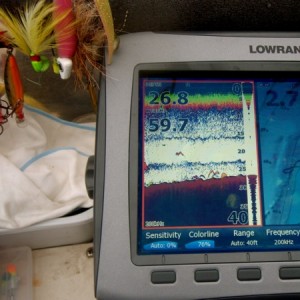 In recent fishing reports and seminars I’ve focused on the importance of thermal layers and salt water stratification in identifying good places to fish. One of the reasons I enjoy fishing around the Chesapeake Bay Bridge is because there are constantly swirling currents where seawater from the ocean mixes with the freshwater from the rivers. Scientists refer to areas where salt and freshwater mix as the Estuarine Turbidity Maximum or ETM. While most Chesapeake Bay researchers put the area of greatest turbidity north of Swan Point, there’s no denying that the water under the Bay Bridge is in a constant state of flux. This creates specific habitat zones which vary depending on the weather, currents, and tides. The challenge for fishermen is to concentrate on the areas where fish are most comfortable because that’s where they are more likely to feed. Once we find the depth, we can optimize our lure selection and modify our presentation so that our chances for hooking up are best. Most of us haven’t heard very much about ETMs, salinity stratification or thermal optimums because we use another term when we talk about those layers. Fishermen call it the Strike Zone. John Page Williams and I decided to sneak in a two-hour pre-work jigging trip this morning in search of the Strike Zone. Read More!
In recent fishing reports and seminars I’ve focused on the importance of thermal layers and salt water stratification in identifying good places to fish. One of the reasons I enjoy fishing around the Chesapeake Bay Bridge is because there are constantly swirling currents where seawater from the ocean mixes with the freshwater from the rivers. Scientists refer to areas where salt and freshwater mix as the Estuarine Turbidity Maximum or ETM. While most Chesapeake Bay researchers put the area of greatest turbidity north of Swan Point, there’s no denying that the water under the Bay Bridge is in a constant state of flux. This creates specific habitat zones which vary depending on the weather, currents, and tides. The challenge for fishermen is to concentrate on the areas where fish are most comfortable because that’s where they are more likely to feed. Once we find the depth, we can optimize our lure selection and modify our presentation so that our chances for hooking up are best. Most of us haven’t heard very much about ETMs, salinity stratification or thermal optimums because we use another term when we talk about those layers. Fishermen call it the Strike Zone. John Page Williams and I decided to sneak in a two-hour pre-work jigging trip this morning in search of the Strike Zone. Read More!
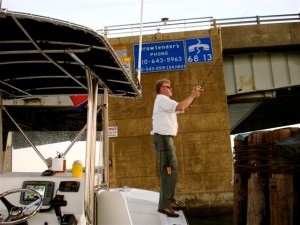 When I first learned I would be moving to the Bay Bridge region of Maryland I read as many books as I could hoping to learn as much as possible about area fishing spots. A recurring theme in everything I read was, there is good fishing around the Chesapeake Bay Bridge. I remember my son Cory saying to me one day as we sat around the dinner table in Knoxville, Tennessee contemplating my move, “Dad, I can’t wait to get up there and fish that bridge.” I was thinking the same thing. Three years and three hundred plus fishing trips later, I still feel the same way. I can’t wait to get out there and fish that bridge! Fortunately, there are several productive bridges near my house on Kent Island. Even though the Bay Bridge is my favorite, I like to fish them all. Here’s my list of the seven most productive bridges within easy driving or cruising distance of the Kent Island/Annapolis area. Read More!
When I first learned I would be moving to the Bay Bridge region of Maryland I read as many books as I could hoping to learn as much as possible about area fishing spots. A recurring theme in everything I read was, there is good fishing around the Chesapeake Bay Bridge. I remember my son Cory saying to me one day as we sat around the dinner table in Knoxville, Tennessee contemplating my move, “Dad, I can’t wait to get up there and fish that bridge.” I was thinking the same thing. Three years and three hundred plus fishing trips later, I still feel the same way. I can’t wait to get out there and fish that bridge! Fortunately, there are several productive bridges near my house on Kent Island. Even though the Bay Bridge is my favorite, I like to fish them all. Here’s my list of the seven most productive bridges within easy driving or cruising distance of the Kent Island/Annapolis area. Read More!
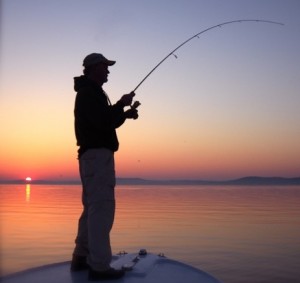 The water was a silent mirror, perfectly reflecting the glittering blush of light in the twilight sky over Elk Neck State Forest. Creig idled my Judge 27CC “Thunder Road” across the glass. He stopped just short of the up-current side of a shallow underwater trench. I fashioned a rapala knot out of thirty-pound fluorocarbon leader and tied on my favorite top-water plug, a silver and orange off-brand spook that I picked out of a junk box at the Pasadena Fishing Flea Market. As Creig shut off the engine, I grabbed my spinning outfit, stepped up on the bow, flipped over the bale spring and waited for our drift to slow. The line felt electric beneath my index finger as I held it tightly against the cork handle and raised my rod tip in anticipation of what would surely be the perfect cast. It was top-water time on the Susquehanna Flats. Read More!
The water was a silent mirror, perfectly reflecting the glittering blush of light in the twilight sky over Elk Neck State Forest. Creig idled my Judge 27CC “Thunder Road” across the glass. He stopped just short of the up-current side of a shallow underwater trench. I fashioned a rapala knot out of thirty-pound fluorocarbon leader and tied on my favorite top-water plug, a silver and orange off-brand spook that I picked out of a junk box at the Pasadena Fishing Flea Market. As Creig shut off the engine, I grabbed my spinning outfit, stepped up on the bow, flipped over the bale spring and waited for our drift to slow. The line felt electric beneath my index finger as I held it tightly against the cork handle and raised my rod tip in anticipation of what would surely be the perfect cast. It was top-water time on the Susquehanna Flats. Read More!
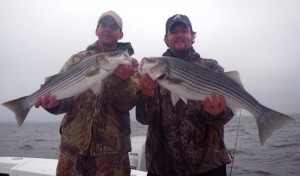 I’m smack in the middle of an intense ten-day fishing stretch with just a little time for a quick report this morning before heading back out on the water. My son Daniel flew in from Tennessee to fish last weekend, and my brother Creig is here until Saturday. I took most of the week off. We’ve been fishing up and down the Bay, wherever the fish are biting or the weather conditions allow. Last weekend, we fished a sixty-four hour window on five and a half hours sleep. Whew! Saturday and Sunday we launched out of Betterton on Maryland’s Eastern Shore. The ramp is narrow and shallow but we managed to unload Thunder Road in the wind and make the 5 mile run north passing the Catch & Release buoys off Aberdeen Proving Ground’s Sandy Point about 6:00 AM. Read More!
I’m smack in the middle of an intense ten-day fishing stretch with just a little time for a quick report this morning before heading back out on the water. My son Daniel flew in from Tennessee to fish last weekend, and my brother Creig is here until Saturday. I took most of the week off. We’ve been fishing up and down the Bay, wherever the fish are biting or the weather conditions allow. Last weekend, we fished a sixty-four hour window on five and a half hours sleep. Whew! Saturday and Sunday we launched out of Betterton on Maryland’s Eastern Shore. The ramp is narrow and shallow but we managed to unload Thunder Road in the wind and make the 5 mile run north passing the Catch & Release buoys off Aberdeen Proving Ground’s Sandy Point about 6:00 AM. Read More!
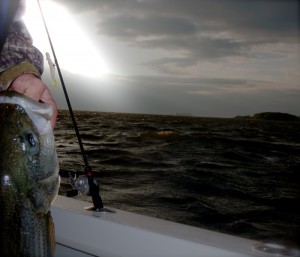 I admit it, I dread the opening day of rockfish kill season like a vampire dreads a tossed salad. In my book, it’s the beginning of the end of good fishing on the Chesapeake Bay. With one stroke of the clock our tranquil miles of open-Bay solitude are overrun by frantic hoards of frenzied fishermen. The meat fleet is out in force on boats bristling with rods the size of rake handles and dozens of lines spread out hundreds of feet using planer board rigs. Lost somewhere in the melee is the concept of one-man-one-rod sportsmanship. To make matters worse, the Department of Natural Resources sets the opening of the kill season while there are still pre-spawn fish in the Bay. Big cows are routinely killed before they have a chance to spread the millions of eggs they are carrying. Maryland, we are sucking the life-blood out of the sport we love by killing our spawning fish. Read More!
I admit it, I dread the opening day of rockfish kill season like a vampire dreads a tossed salad. In my book, it’s the beginning of the end of good fishing on the Chesapeake Bay. With one stroke of the clock our tranquil miles of open-Bay solitude are overrun by frantic hoards of frenzied fishermen. The meat fleet is out in force on boats bristling with rods the size of rake handles and dozens of lines spread out hundreds of feet using planer board rigs. Lost somewhere in the melee is the concept of one-man-one-rod sportsmanship. To make matters worse, the Department of Natural Resources sets the opening of the kill season while there are still pre-spawn fish in the Bay. Big cows are routinely killed before they have a chance to spread the millions of eggs they are carrying. Maryland, we are sucking the life-blood out of the sport we love by killing our spawning fish. Read More!
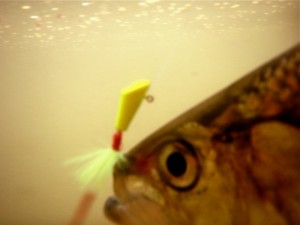 Besides gannet storms, April showers bring cherry blossoms and tourists to the Mid-Atlantic. Since cherry trees were first planted around the Tidal Basin in 1912, people from all over the world travel to Washington DC to welcome the arrival of spring. This is also the time when fishermen look forward to other visitors making their way up the Potomac. In April, the hickory shad run begins bringing some of the most exciting fishing of the year. Hickory and white shad are anadromous species that spend the vast majority of their lives at sea, but enter the Chesapeake region in the spring. They swim through the Bay and up the rivers looking for the fast water they need in order to spawn. Shad hold an important place in American history. The Native Americans fished for them extensively and used them to fertilize their crops. George Washington was known as a prolific shad angler and caught thousands near his home on at Mount Vernon. It was the spring shad run in Pennsylvania’s Schuylkill River that saved Washington’s army from starvation at Valley Forge.
Besides gannet storms, April showers bring cherry blossoms and tourists to the Mid-Atlantic. Since cherry trees were first planted around the Tidal Basin in 1912, people from all over the world travel to Washington DC to welcome the arrival of spring. This is also the time when fishermen look forward to other visitors making their way up the Potomac. In April, the hickory shad run begins bringing some of the most exciting fishing of the year. Hickory and white shad are anadromous species that spend the vast majority of their lives at sea, but enter the Chesapeake region in the spring. They swim through the Bay and up the rivers looking for the fast water they need in order to spawn. Shad hold an important place in American history. The Native Americans fished for them extensively and used them to fertilize their crops. George Washington was known as a prolific shad angler and caught thousands near his home on at Mount Vernon. It was the spring shad run in Pennsylvania’s Schuylkill River that saved Washington’s army from starvation at Valley Forge.
Read More!


